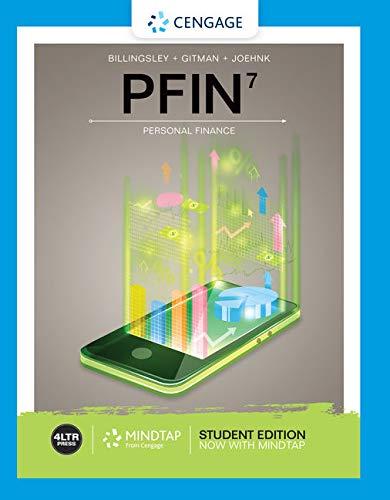
a
To determine: The debt payments-to-disposable income ratio.
Introduction:
Establishment of debit limit:A debit limit is the overall maximum credit one should get based on his ability to meet the repayment obligations. The recommended safe debt limit is considered to be 11 to 14 percent debt payment limits as percentage of disposable personal income, the length of time that high debt payment is also important to consider.
They are three recommended methods for you to determine the debt limit.
- Continuous-debt method:under this method, it is evaluated if it is difficult to get out of debt completely every four years, if yes it shows you are heavily dependent on debt.
- Debt payments-to-disposable income method: it uses the debt payment to disposable income ratio excluding mortgage loan, it focuses on the amount of monthly debt repayment.
- Debt-to-income method: it is based on the ratio of debt to income a ratio of 36 percent or less is desirable.
a
Answer to Problem 1DTM
KJ’s debt payment to disposable income ratio is 21%. It is way above the desired ratio of 14%
Explanation of Solution
Debt payment to disposable income can be calculated by following formula
K has an outstanding student loan for which he pays $900 per month and auto loan repayment $300 hence total non-mortgage loan payment debt is $1,200 and his disposable income
| Amount $ | |
| Salary | 9,000 |
| Less: Federal tax | (1,800) |
| State tax | (500) |
| Medicare | (700) |
| Social security tax | (230) |
| Disposable income | 5,770 |
b
To determine: Whether K’s plan to go for an automobile loan to buy a motorcycle is feasible.
Introduction:
Establishment of debit limit:A debit limit is the overall maximum credit one should get based on his ability to meet the repayment obligations. The recommended safe debt limit is considered to be 11 to 14 percent debt payment limits as percentage of disposable personal income, the length of time that high debt payment is also important to consider.
They are three recommended methods for you to determine the debt limit.
- Continuous-debt method: under this method, it is evaluated if it is difficult to get out of debt completely every four years, if yes it shows you are heavily dependent on debt.
- Debt payments-to-disposable income method: it uses the debt payment to disposable income ratio excluding mortgage loan, it focuses on the amount of monthly debt repayment.
- Debt-to-income method: it is based on the ratio of debt to income a ratio of 36 percent or less is desirable.
b
Answer to Problem 1DTM
KJ should not go for another loan, as his debt payment to disposable income is not good.
Explanation of Solution
Estimated funds available for debt repayment is expected to less than 14%. Because K’s ratio is 21%, he may face difficulty in repayment of additional debt as he has too low disposable income. It will also affect spending capacity and may affect liquidity position of an individual that is he may face difficulty in managing day to day expenses, thus.It is not advisable for him to go for one more debt, as he may face difficulty in repayment of one more loan.
Want to see more full solutions like this?
Chapter 6 Solutions
Personal Finance Tax Update
- You invest $5,000 in a project, and it generates $1,250 annually. How long will it take to recover your investment? Exparrow_forwardThe value of an investment grows from $10,000 to $15,000 in 3 years. What is the CAGR?Soovearrow_forwardSuppose that the treasurer of IBM has an extra cash reserve of $100,000,000 to invest for six months. The six-month interest rate is 9 percent per annum in the United States and 8 percent per annum in Germany. Currently, the spot exchange rate is €1.07 per dollar and the six-month forward exchange rate is €1.05 per dollar. The treasurer of IBM does not wish to bear any exchange risk. Where should they invest to maximize the return? Required: The maturity value in six months if the extra cash reserve is invested in Germany:arrow_forward
- The value of an investment grows from $10,000 to $15,000 in 3 years. What is the CAGR?arrow_forwardYou invest $5,000 in a project, and it generates $1,250 annually. How long will it take to recover your investment?arrow_forwardA company pays an annual dividend of $3 per share, and the current stock price is $50. What is the dividend yield?arrow_forward
- You invest $1,000 in a stock, and after 2 years, it grows to $1,200. What is the annual return?arrow_forwardYou invest $1,000 in a stock, and after 2 years, it grows to $1,200. What is the annual return? Exparrow_forwardWells and Associates has EBIT of $ 72800. Interest costs are $ 18400, and the firm has 15600 shares of common stock outstanding. Assume a 40 % tax rate. a. Use the degree of financial leverage (DFL) formula to calculate the DFL for the firm. b. Using a set of EBIT -EPS axes, plot Wells and Associates' financing plan. c. If the firm also has 1200 shares of preferred stock paying a $ 5.75 annual dividend per share, what is the DFL? d. Plot the financing plan, including the 1200 shares of $ 5.75 preferred stock, on the axes used in part (b). e. Briefly discuss the graph of the two financing plans.arrow_forward
- You invest $5,000 for 3 years at an annual interest rate of 6%. The interest is compounded annually. Need helparrow_forwardWhat is the future value of $500 invested for 3 years at an annual compound interest rate of 4%? Explarrow_forwardYou invest $5,000 for 3 years at an annual interest rate of 6%. The interest is compounded annually.arrow_forward
 Pfin (with Mindtap, 1 Term Printed Access Card) (...FinanceISBN:9780357033609Author:Randall Billingsley, Lawrence J. Gitman, Michael D. JoehnkPublisher:Cengage Learning
Pfin (with Mindtap, 1 Term Printed Access Card) (...FinanceISBN:9780357033609Author:Randall Billingsley, Lawrence J. Gitman, Michael D. JoehnkPublisher:Cengage Learning





